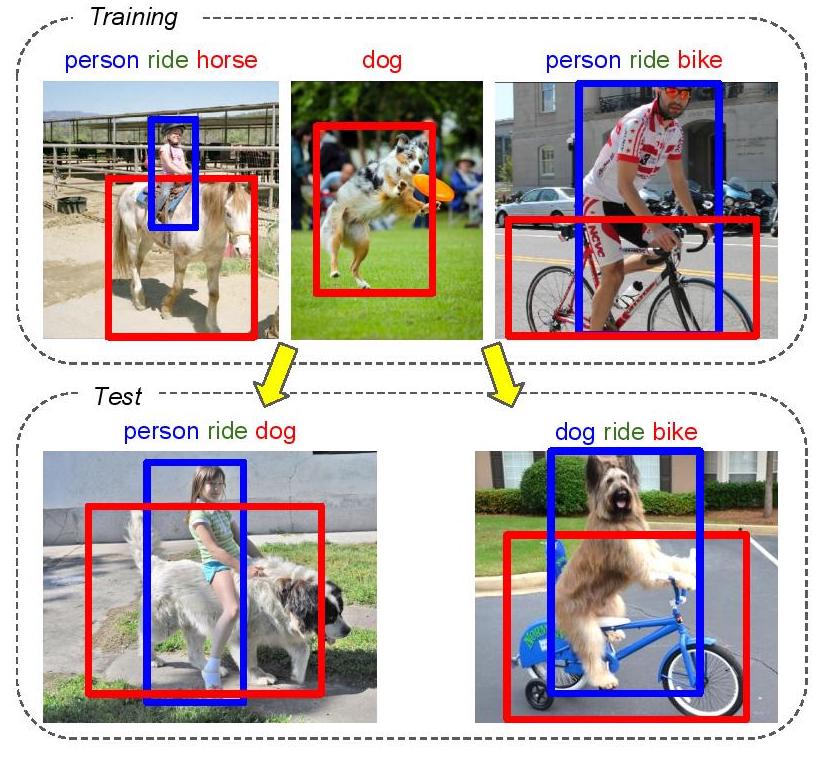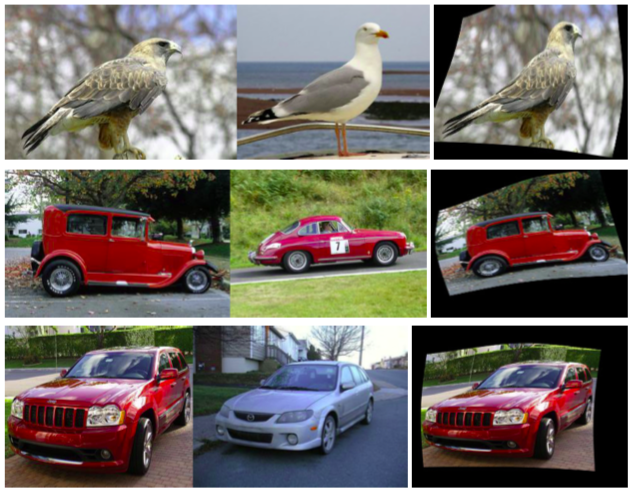Section: New Results
Category-level object and scene recognition
Detecting rare visual relations using analogies
Participants : Julia Peyre, Cordelia Schmid, Ivan Laptev, Josef Sivic.
We seek to detect visual relations in images of the form of triplets t = (subject, predicate, object), such as "person riding dog", where training examples of the individual entities are available but their combinations are rare or unseen at training such as shown in Figure 7. This is an important set-up due to the combinatorial nature of visual relations : collecting sufficient training data for all possible triplets would be very hard. The contributions of this work are three-fold. First, we learn a representation of visual relations that combines (i) individual embeddings for subject, object and predicate together with (ii) a visual phrase embedding that represents the relation triplet. Second, we learn how to transfer visual phrase embeddings from existing training triplets to unseen test triplets using analogies between relations that involve similar objects. Third, we demonstrate the benefits of our approach on two challenging datasets involving rare and unseen relations : on HICO-DET, our model achieves significant improvement over a strong baseline, and we confirm this improvement on retrieval of unseen triplets on the UnRel rare relation dataset. This work, currently under review, can be found at [31].
|
Convolutional neural network architecture for geometric matching
Participants : Ignacio Rocco, Relja Arandjelović, Josef Sivic.
In [9], we address the problem of determining correspondences between two images in agreement with a geometric model such as an affine, homography or thin-plate spline transformation, and estimating its parameters. The contributions of this work are threefold. First, we propose a convolutional neural network architecture for geometric matching. The architecture is based on three main components that mimic the standard steps of feature extraction, matching and simultaneous inlier detection and model parameter estimation, while being trainable end-to-end. Second, we demonstrate that the network parameters can be trained from synthetically generated imagery without the need for manual annotation and that our matching layer significantly increases generalization capabilities to never seen before images. Finally, we show that the same model can perform both instance-level and category-level matching giving state-of-the-art results on the challenging PF, TSS and Caltech-101 datasets.
End-to-end weakly-supervised semantic alignment
Participants : Ignacio Rocco, Relja Arandjelović, Josef Sivic.
In [17], we tackle the task of semantic alignment where the goal is to compute dense semantic correspondence aligning two images depicting objects of the same category. This is a challenging task due to large intra-class variation, changes in viewpoint and background clutter. We present the following three principal contributions. First, we develop a convolutional neural network architecture for semantic alignment that is trainable in an end-to-end manner from weak image-level supervision in the form of matching image pairs. The outcome is that parameters are learnt from rich appearance variation present in different but semantically related images without the need for tedious manual annotation of correspondences at training time. Second, the main component of this architecture is a differentiable soft inlier scoring module, inspired by the RANSAC inlier scoring procedure, that computes the quality of the alignment based on only geometrically consistent correspondences thereby reducing the effect of background clutter. Third, we demonstrate that the proposed approach achieves state-of-the-art performance on multiple standard benchmarks for semantic alignment. Figure 8 presents some example results.
|
Neighbourhood Consensus Networks
Participants : Ignacio Rocco, Mircea Cimpoi, Relja Arandjelović, Akihiko Torii, Tomas Pajdla, Josef Sivic.
In [18], we address the problem of finding reliable dense correspondences between a pair of images. This is a challenging task due to strong appearance differences between the corresponding scene elements and ambiguities generated by repetitive patterns. The contributions of this work are threefold. First, inspired by the classic idea of disambiguating feature matches using semi-local constraints, we develop an end-to-end trainable convolutional neural network architecture that identifies sets of spatially consistent matches by analyzing neighbourhood consensus patterns in the 4D space of all possible correspondences between a pair of images without the need for a global geometric model. Second, we demonstrate that the model can be trained effectively from weak supervision in the form of matching and non-matching image pairs without the need for costly manual annotation of point to point correspondences. Third, we show the proposed neighbourhood consensus network can be applied to a range of matching tasks including both category- and instance-level matching, obtaining the state-of-the-art results on the PF Pascal dataset and the InLoc indoor visual localization benchmark. Figure 9 shows the network architecture of the proposed Neighbourhood Consensus Network, that features 3 layers of 4D convolutions.
|
Compressing the Input for CNNs with the First-Order Scattering Transform
Participants : Edouard Oyallon, Eugene Belilovsky, Sergey Zagoruyko, Michal Valko.
In [16], we study the first-order scattering transform as a candidate for reducing the signal processed by a convolutional neural network (CNN). We study this transformation and show theoretical and empirical evidence that in the case of natural images and sufficiently small translation invariance, this transform preserves most of the signal information needed for classification while substantially reducing the spatial resolution and total signal size. We show that cascading a CNN with this representation performs on par with ImageNet classification models commonly used in downstream tasks such as the ResNet-50. We subsequently apply our trained hybrid ImageNet model as a base model on a detection system, which has typically larger image inputs. On Pascal VOC and COCO detection tasks we deliver substantial improvements in the inference speed and training memory consumption compared to models trained directly on the input image.
Exploring Weight Symmetry in Deep Neural Networks
Participants : Xu Shell Hu, Sergey Zagoruyko, Nikos Komodakis.
In [27], we propose to impose symmetry in neural network parameters to improve parameter usage and make use of dedicated convolution and matrix multiplication routines. Due to significant reduction in the number of parameters as a result of the symmetry constraints, one would expect a dramatic drop in accuracy. Surprisingly, we show that this is not the case, and, depending on network size, symmetry can have little or no negative effect on network accuracy, especially in deep overparameterized networks. We propose several ways to impose local symmetry in recurrent and convolutional neural networks, and show that our symmetry parameterizations satisfy universal approximation property for single hidden layer networks. We extensively evaluate these parameterizations on CIFAR, ImageNet and language modeling datasets, showing significant benefits from the use of symmetry. For instance, our ResNet-101 with channel-wise symmetry has almost 25% less parameters and only 0.2% accuracy loss on ImageNet.





